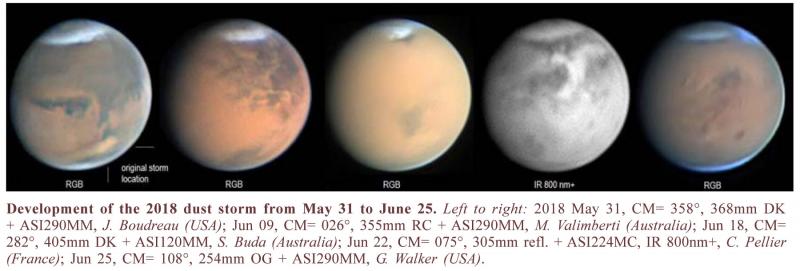A major dust storm on Mars
2018 July 19

For the present opposition of the planet I have maintained a running commentary on the Section website, www.britastro.org/mars. On average this is uploaded more often than once a week. Summaries will be prepared for the Journal later, but for now it is important to write a few words about the major dust storm that has been affecting the planet since late May. The text below includes extracts from the website.
Images on May 30 had first shown a patch of bright dust at the SE of Mare Acidalium. On May 31 the bright yellow cloud had greatly expanded, and was a striking feature. Bright dust clouds were observed from N. Chryse-Xanthe to Aram (Thymiamata) on Jun 2, as the storm front expanded south. On Jun 3 secondary activity was raising dust along part of Valles Marineris. N. Margaritifer Sinus was blotted out.
This cycle of activity is typical. What is unusual is that the initial dust cloud arose over SE Mare Acidalium and not the customary site of Chryse Planitia further west. Another unusual point is the large size of the dust cloud SE of Acidalium. Historical data demonstrate that such cross-equatorial storms that commence in and around Chryse Planitia may grow to achieve Regional status, but have never become planet-encircling.
By Jun 16 considerable expansion and secondary activity had taken place, the fine details of which we shall not give here, but there remained an unaffected swathe of longitude some 100° long, even though some were already calling the event Encircling.
The dust that had effaced Margaritifer Sinus spread east, invading Noachis and blotting out all of the normally very dark and contrasty Sinus Sabaeus. The intensity of Syrtis Major was considerably reduced. A further local outbreak of dust occurred in the Hellas basin, and this activity spread east and northeast into Ausonia and across Hesperia. The images on Jun 12 show dust cutting across Mare Tyrrhenum. Meanwhile, the dust storm over the Valles Marineris region had spread to the south, as already reported, and had even reached the edge of the SPC, spilling onto the cap. Valles Marineris itself appeared as a complex bright yellow streak, with dust marking out the intricacies of its interior geography.
As the storm encroached upon Thaumasia, another independent burst of dust was seen over Solis Lacus on Jun 10, though this did not develop next day. After some complex albedo changes the Solis Lacus was nearly back to normal on Jun 12. On Jun 12 several observers recorded another brilliant yellow local cloud, this time over Daedalia, which like Solis Lacus is well-known as a storm initiation site. However, this local storm also dispersed.
A few days later however, a new burst of dust from the area of Solis Lacus appeared, expanding both south and west, so that eventually the previously unaffected hemisphere was laden with dust. At the same time, the previously affected longitudes were gradually returning to normal. At the time of writing (June 24), the longitudes from Syrtis Major to Meridiani Sinus are again recognisable, if below normal intensity. Some striking albedo anomalies have appeared. Mare Tyrrhenum-Mare Cimmerium are presently obscured.
During the last few days there has been a sharply enhanced brightening and whitening of the morning limb just north of the S. polar cap, which even appears strongly bluish in some images. This bright cloud was a characteristic of the 2001 global storm. See my final report on that opposition in Journal, 119, 123-143 and 205-211 (2009).
The highest resolution images now show much detail in the SPC. The area of Novus Mons (the so-called ‘Mountains of Mitchell’) is brighter than its surroundings, and is expected to detach from the cap at Ls= 238° (as it did in 2003) or 239° (1988). In 2018 the corresponding dates are August 25-28.
Richard McKim, Director, Mars Section
| The British Astronomical Association supports amateur astronomers around the UK and the rest of the world. Find out more about the BAA or join us. |
